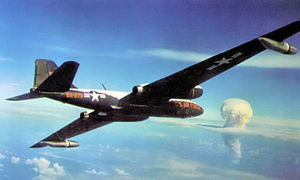RB-57D
| RB-57D Canberra | |
|---|---|
 |
|
| Martin RB-57D-2 Model 796 53-3979 collecting atmospheric particle samples during Juniper nuclear bomb explosion; Operation Hardtack I Bikini atomic experiments, 22 July 1958. | |
| Role | Reconnaissance |
| Manufacturer | Martin |
| First flight | 3 November 1955 |
| Introduction | April 1956 |
| Retired | 1979 (EB-57D) |
| Status | Retired |
| Primary users |
United States Air Force Republic of China Air Force |
| Number built | 20 |
| Developed from | Martin B-57 Canberra |
The Martin RB-57D Canberra was a specialized high-altitude strategic reconnaissance aircraft developed from the Martin B-57 Canberra tactical bomber, a licence-built version of the English Electric Canberra. It was used by the United States Air Force during the 1950s prior to operational use of the Lockheed U-2.
The RB-57D was built strictly as a high-altitude reconnaissance aircraft. It originated in a December 1952 USAF study funded by the Wright Air Development Center for a turbojet-powered special reconnaissance aircraft with a radius of 2,000 nautical miles (3,700 km; 2,300 mi) that could operate at altitudes of 65,000 feet (20,000 m). Subsonic performance was considered to be acceptable and it was felt that no defensive armament would be needed. The RB-57D was unique and set the stage for high-altitude reconnaissance operations in the rarefied air of the stratosphere. Preliminary specifications were prepared by the Air Force on 27 March 1953. The project was carried out in high secrecy. It was known as Weapon System MX-2147, and the code name was Bald Eagle.
The basic B-57 Canberra design was used as a starting point for the D model, but there were several significant changes incorporated. The most obvious was the greatly enlarged wing. The wingspan was lengthened by 42 feet (13 m) to 106 feet (32 m) overall. The chord of the wing was also increased, which combined with the increased length gave the wing a very high lift capability.
The second major change to the RB-57D was the addition of Pratt & Whitney J57 engines in place of the Wright J65 engines used on all earlier B-57 models. The two J57 engines produced about 20,000 lbf (89.0 kN) total thrust, about 6,000 lbf (26.7 kN) more than the two J65 engines. Other changes in the D model included removal of all fuselage fuel tanks and the addition of "wet wing" fuel cells. All defensive armament was removed, and the bomb bay was also removed and replaced by avionics equipment. The horizontal stabilizer was changed to the variable incidence or "all flying" type. Spoilers were added to the outboard wings to assist the ailerons in roll axis control.
...
Wikipedia
